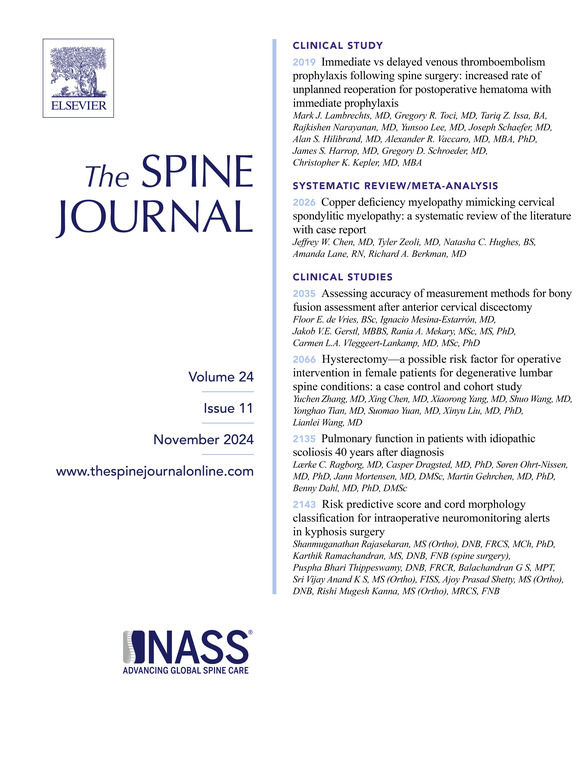硬脑膜成形术通过减轻兔严重脊髓压迫损伤后的椎管内压力和水肿来促进功能恢复:实验研究。
IF 4.9
1区 医学
Q1 CLINICAL NEUROLOGY
引用次数: 0
摘要
背景:目的:我们的研究旨在探讨椎板成形术和椎板切除术对严重球囊压迫性脊髓损伤后水肿进展、灌注和功能预后的影响:研究设计:体内动物实验:方法:用 50 μl 的充气量在兔子 T7 水平诱发闭合性气囊压迫损伤。模型生成后立即进行椎板切除术(1 级椎板切除术:1-laminectomy;3 级椎板切除术:3-laminectomy)和持久成形术。SCI术后7天内,使用SOPHYSA探针在震中监测ISP。脊髓损伤后 8 周内,通过连续多序列核磁共振扫描、行为和膀胱评分评估水肿进展、灌注和损伤严重程度。随后对血脊髓屏障(BSCB)通透性和组织病理学进行了分析:结果:SCI后,对照组和1椎板切除组的ISP陡然升高,在SCI后48小时分别达到33.14±4.91和31.71±4.50 mmHg的峰值;而在3椎板切除组和持久成形术组,ISP分别达到29.43±4.04和12.14±1.86 mmHg的峰值(p结论:持久成形术可减轻继发性 SCI 并促进功能恢复。这种神经保护机制可能与ISP降低和灌注增加有关,从而导致水肿、BSCB通透性和炎症降低,神经纤维束保存增加:临床意义:Duraplasty 可促进重度 tSCI 患者的功能恢复,但仍需进一步研究。本文章由计算机程序翻译,如有差异,请以英文原文为准。
Duraplasty promotes functional recovery by alleviating intraspinal pressure and edema following severe spinal cord compression injury in rabbits: experimental studies
BACKGROUND
After acute traumatic spinal cord injury (tSCI), various surgical strategies have been developed to alleviate elevated intraspinal pressure (ISP) and secondary injury.
PURPOSE
Our study aimed to investigate the impacts of duraplasty and laminectomy on edema progression, perfusion and functional outcomes after severe balloon compression SCI.
STUDY DESIGN
In vivo animal study.
METHODS
Closed balloon compression injuries were induced at the T7 level in rabbits using an inflated volume of 50 μl. Laminectomy (1-level laminectomy: 1-laminectomy; 3-level laminectomy: 3-laminectomy) and duraplasty were performed immediately after model generation. ISP was monitored using a SOPHYSA probe at the epicenter within 7 days post-SCI. Edema progression, perfusion and damage severity were evaluated by serial multisequence MRI scans, behavioral and bladder scores within 8 weeks post-SCI. Blood-spinal cord barrier (BSCB) permeability and histopathology were subsequently analyzed.
RESULTS
After SCI, ISP was steeply elevated in the control and 1-laminectomy groups, peaking at 33.14±4.91 and 31.71±4.50 mmHg at 48 h post-SCI; whereas in the 3-laminectomy and duraplasty groups, ISP peaked at 29.43±4.04 and 12.14±1.86 mmHg (p<.0001) at 72 h post-SCI. MRI and function scores showed that duraplasty significantly reduced the intramedullary lesion length (IMLL) and blood flow reduction ratio, and promoted fiber tract sparing and spinal cord functional recovery (p<.01). Histopathology revealed that duraplasty significantly reduced BSCB permeability, tissue loss and inflammation and promoted axon preservation (p<.01), while it did not increase early scar formation.
CONCLUSIONS
Duraplasty may alleviate secondary SCI and promote functional recovery. This neuroprotective mechanism may be related to reduced ISP and increased perfusion, resulting in reduced edema, BSCB permeability and inflammation and increased nerve fiber tract preservation.
CLINICAL SIGNIFICANCE
Duraplasty may promote functional recovery following severe tSCI patients, but further investigations are needed.
求助全文
通过发布文献求助,成功后即可免费获取论文全文。
去求助
来源期刊

Spine Journal
医学-临床神经学
CiteScore
8.20
自引率
6.70%
发文量
680
审稿时长
13.1 weeks
期刊介绍:
The Spine Journal, the official journal of the North American Spine Society, is an international and multidisciplinary journal that publishes original, peer-reviewed articles on research and treatment related to the spine and spine care, including basic science and clinical investigations. It is a condition of publication that manuscripts submitted to The Spine Journal have not been published, and will not be simultaneously submitted or published elsewhere. The Spine Journal also publishes major reviews of specific topics by acknowledged authorities, technical notes, teaching editorials, and other special features, Letters to the Editor-in-Chief are encouraged.
 求助内容:
求助内容: 应助结果提醒方式:
应助结果提醒方式:


